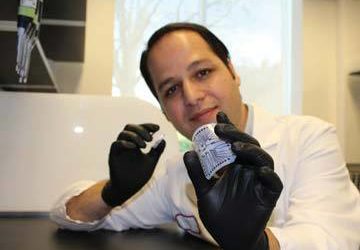
“One of our main goals is to provide this low cost platform in low- resource settings area in Asia, Africa and even Latin American nations. We are very hopeful that this inexpensive and multi-functional platform enables greater individual access to diagnostic facilities in the developing countries,” says Rahim Esfandyarpour of Stanford University in an email to localhost/muslim.
Timely detection of the disease plays an important role in the treatment to save lives. According to the World Health Organization (WHO), breast cancer mortality is increasing in developing nations as compared to developed countries. 58 per cent of deaths occur in developing nation due to low detection of this cancer at early stage.
The survival rates of breast cancer are as high as 80 per cent in developed nations but almost half (40 per cent) in the low-income nations just because the absence of timely and affordable diagnosis facilities.
Draw, download, print and predict
The simple hand held lab comprises of two important parts; a clear silicone microfluidic chamber sits on a reusable electronic strip.
The silicone chamber holds the sample cells of disease and the electronic chip is made from polyester sheet on which circuit is carved through commercially available nano particle ink acts as conductor. The whole printing process needs just 20 minutes. User can download electronic designs to print for the different applications and this feature turns the strip into a multifunctional diagnostic platform
Instead of using fluorescent ink or other markers to look for diseases, the chip works by applying electric charge which separates the cells and drive them into different directions. Due to their “polarizability” – intrinsic electrical features – the cells pulled in different directions in the microfluidic chamber. This process helps to catch the disease at early stage, for instance it can separate the tumor cells in the blood sample as their charges are different.
Apart from separating the cells by type, the researchers can also switch to counting cells by printing a new circuit at the strip. In future an open database of different designs could be set for the required tasks that can easily be downloaded, printed out and use for various applications.
From lab to the field
The technology is simple with the high-tech concepts of microfluidics, electronics and inkjet printing technology. The low cost compact lab on chip could revolutionize disease diagnostics especially in the remote areas of low income regions. In future, only one lab assistant can produce cheap strip to look for HIV or malaria in a village in Africa or at the mountains of Afghanistan. The team is now looking for investors to commercialize their promising idea.
“We think the technology has the potential to not only advance health care, but also to accelerate basic and applied research around the globe. Although we have very promising results, we expect a bit more work toward commercialization of the solution,” Esfandyarpour added.
Rahim Esfandyarpour received his BSc from K N Toosi University in Tehran, Iran.
After doctorate in Electrical Engineering from Stanford University, he is currently working at the Genome Technology Center at the same university.